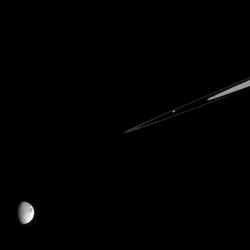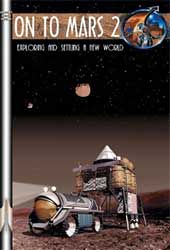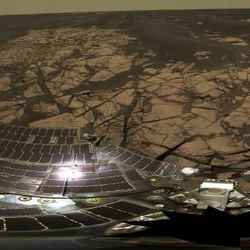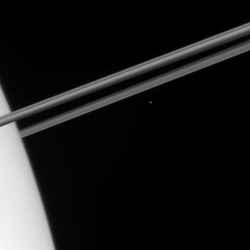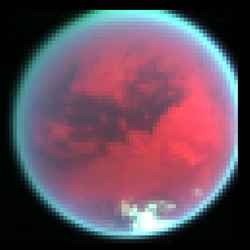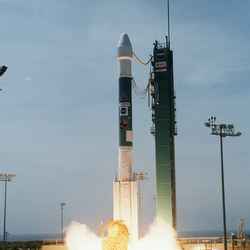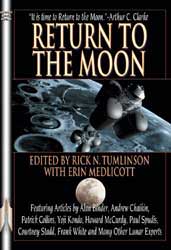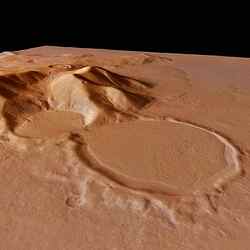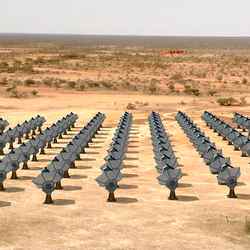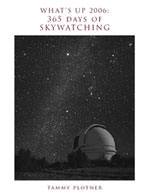
Download our free “What’s Up 2006” ebook, with entries like this for every day of the year.
|
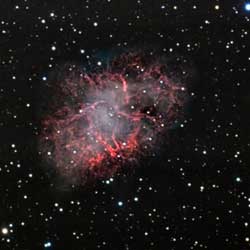
M1: “The Crab Nebula”. Image credit: R. Jay GaBany. Click to enlarge.
Monday, January 23 – Thanks to dark skies, tonight will be the perfect opportunity to “go crabbing” in Taurus. Although M1 was discovered by John Bevis in 1731, it became the first object on Charles Messier’s astronomical list. He rediscovered M1 while searching for the expected return of Halley’s Comet in late August 1758 and these “comet confusions” prompted Messier to start cataloging. It wasn’t until Lord Rosse gathered enough light from M1 in the mid-1840’s that the faint filamentary structure was noted (although he may not have given the Crab Nebula its name). To have a look for yourself, locate Zeta Tauri and look about a finger-width northwest. You won’t see the “Crab legs” in small scopes – but there’s much more to learn about this famous “supernova remnant” in the future.
Tuesday, January 24 – Today is the birthday of American solar astronomer Harold Babcock. Born in 1882, Babcock proposed that the sunspot cycle was a result of the Sun’s differential rotation and magnetic field in 1961. Would you like to have a look at the Sun? Although solar observing is best done with a proper filter, it is perfectly safe to use the “solar projection method.”
Before we start, NEVER look at the Sun directly with the eye or with any unfiltered optical device, such as binoculars or a telescope. We’re not joking when we say this will blind you. Exposed film, mylar, and smoked glass are also UNSAFE. But don’t be afraid, because we’re here to tell you how you can enjoy solar viewing. A safe way to observe sunspots is to “project” an image of the Sun through a telescope or binoculars onto a screen. This can be as simple as cardboard, a paper plate, a wall or whatever you have handy. If you’re using a telescope be sure the finderscope is securely capped. If you use binoculars, cover one of the two tubes. By using the shadow method to aim, you will see a bright circle of light on your makeshift screen. This is the solar disc. Adjust the focus by moving the distance of the screen from your optics until it’s about the size of a small plate. If the image is blurry, use manual focus until the edges of the disc become sharp. Even though it might take a little practice, you’ll soon become proficient at this method and be able to see a surprising amount of detail in and around sunspot areas. Happy and SAFE viewing to you!
Today in 1986, the United States Voyager 2 became the first spacecraft to fly by Uranus, providing us with the most outstanding photographs and information on the planet to date. After 10,382 days of successful operation, Voyager 2 still continues on towards the stars carrying “The Sounds of Earth.”
Speaking of stars, turn your scope on brilliant Rigel – Orion’s south-westernmost bright star. Enjoy its cool radiance and look for an 8th magnitude companion just outside the spikes of light caused by the Earth’s atmosphere.
Wednesday, January 25 – This morning before dawn, look for the Moon very near Antares. Many observers in the southern portions of Mexico, Peru and Ecudor will have the opportunity to see it occulted, so please check with the International Occultation Timing Association (IOTA) for details.
Today is the birthday of Joseph Louis Lagrange. Born in 1736, the famed French mathematician made important contributions to the field of celestial mechanics. We’re not talking “wrenches in space,” but how masses interact gravitationally to keep things orderly in the solar system and beyond. If you’re up early this morning, have a look at the lunar crater named for him. You’ll find LaGrange on the southern limb about one-quarter the distance up from the cusp. But, you won’t find the SOHO satellite there. NASA’s “eye on Sol” is parked at Lagrange point one (L1) between the Earth and Sun.
Tonight let’s journey to Orion and have a look at a pair of neighboring open clusters. Found a little less than a hand span northwest of Betelguese, NGC 1807 and NGC 1817 aren’t exactly twins. Both clusters are of similar magnitude and can be seen as faint patches in binoculars. Through a telescope, NGC 1817 appears far more populated with stars than its neighbor. Studies based on stellar motion reveal that NGC 1817 has far more stars than the brighter NGC 1807. Although the two are quite distant from one another in space, we get to see them both as close friends…
Thursday, January 26 – In keeping with our dark sky studies, tonight we’ll explore planetary nebula NGC 1514 in Taurus. Locate it by moving about two finger-width’s south-east of Zeta Perseii. Planetary nebulae were first described as “planetary” by William Herschel in 1785. Before then, all were simply considered “nebulae.” It was once thought they were made of stars, but today we know planetaries are created from material given off by a single star. Many show well-defined rings of one type or another. Others – like M1 – are irregularly shaped supernova remnants. NGC 1514’s material is slowly boiled off over time, rather than caused by a violent explosion.
It would be very hard to find the neutron central star in M1, but almost any scope can make out NGC 1514’s 10th magnitude fueling star as it quietly cooks away gases to feed its nebulous shroud. Because it is so bright, it can easily overwhelm the eye. This makes NGC 1514 similar to the famous “Blinking Planetary” – NGC 6826 – in Cygnus.
Friday, January 27 – The planet Saturn is at opposition tonight, meaning it rises as the Sun sets. Look for it late in the evening moving past M44 – “the Beehive” – cluster in Cancer. The 2006 apparition will continue to feature Saturn’s rings and the planet’s southern hemisphere.
Are you ready for more deep sky? Then let’s head off towards the galaxy NGC 1023 in Perseus. It’s a beautiful example of a slightly tilted “SB0” spiral galaxy. You won’t see any spiral arms on this one – but not because your telescope isn’t large enough. Unlike our own Milky Way, NGC 1023 really doesn’t have any. But, it does have a bright galactic hub bending like a thick lens going outward. At the center of the hub is one of the most massive black holes within a hundred million light-years. Don’t worry about being pulled in, because this galaxy is located 33 million light-years away! You’ll find it a bit closer to home about a fist-width southwest of Algol – Beta Persei.
There is a much closer supermassive black hole at the center of our own galaxy. It’s a profound gravitational anomaly causing stars to take on strange, highly elliptical orbits at very high speeds – some which have orbits taking far less time than Jupiter does to revolve around the Sun. The stars involved (“S-stars”) appear mysteriously young to astronomers. This might occur because their outer atmospheres are being stripped away by gravitational tidal forces. It’s happening in NGC 1023 as well, but that galaxy is ten times more massive than our own!
Saturday, January 28 – It’s Saturday and New Moon! Many amateurs will be out tonight “partying” beneath the darkest night sky of the month. All that’s needed is a wide-open field well away from glow from artificial lights and a variety of optical instruments – eyes, binoculars, and telescopes. The joy of observing can be multiplied many times over when shared with others!
What should you bring to a “star party?” Start with your favorite scope and a short list of things to observe including both “everybody’s favorites” and at least one “special study” that others may not have observed before! Tonight, the two “Greats” – M31 and M42 – will be on everyone’s list, but what about those “great” unknowns?
Consider NGC 1535 – a fine planetary nebula with central star in Eridanus. At magnitude 10, this 1600 light-year distant beauty has an easy 12th magnitude star providing illumination at its core. Use high power to give “image scale” to this small, subtle study. You’ll find it just about a fist’s width east-northeast of Gamma Eridani. If you find it difficult, you’d be right – but that’s why this aqua blue planetary is not more widely appreciated!
Sunday, January 29 – Today is the birthday of Johannes Hevelius. Born in 1611, Hevelius was the first to publish detailed maps of the Moon. His book, Selenographia, debuted in 1647. That’s 359 years ago – and it’s still accurate! Too bad there’s no Moon to celebrate with… Or is it?
Let’s have a look instead at the Pleiades – M45. We aren’t finished observing the Pleiades yet, because the “Seven Sisters” may not be finished either. On a moonless night, you can see the afterbirth of stellar creation – the faint sheen of nebulosity illuminated by hot stars doing their best to “light up the night.” Most easily spotted is NGC 1435 associated with Merope and NGC 1432 near Maia. To be sure you are seeing the nebulosity, look well away from both stars. From Merope (the southernmost bright star) look due south – away from the brightest stars of the cluster. Compare that to the nebulosity which surrounds all seven major stars – but especially Maia – north of Merope. Be sure not to stare directly. They will appear like a pale smear or a “fog” on your optics. Move your eyes around to activate the sensitive light-receptors in the eye – that’s using your eyes to advantage!
Until next week? May all of your journeys be at… Light Speed! ~Tammy Plotner
Contributing Writer: Jeff Barbour @ astro.geekjoy.com
